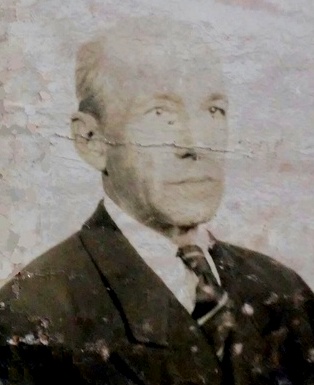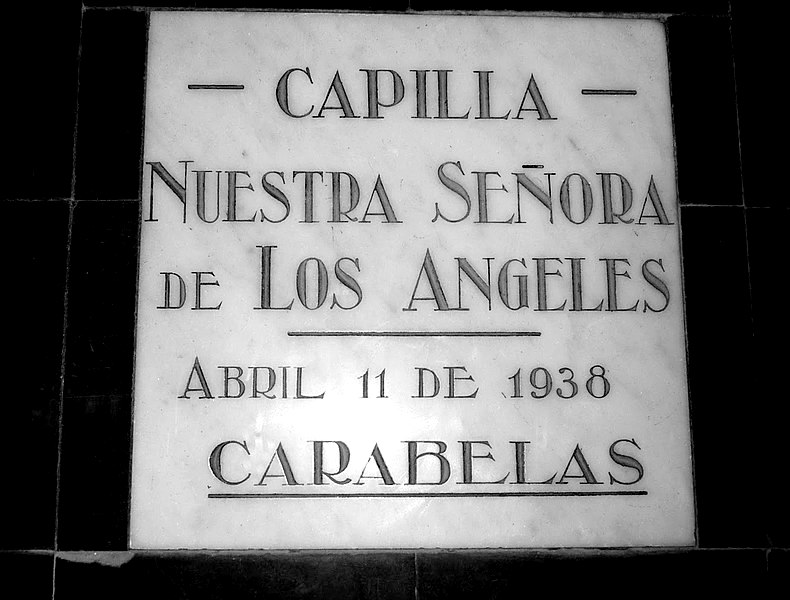Dr. Carlos R. Foster
Family
Carlos Roberto Foster was the son of María Dolores Castaño (c.1868-?), a native of Spain who came with her family to Buenos Aires to escape the Revolution of 1868, and Enrique Arturo Foster (1865-c.1940), a prosperous Argentine merchant and politician who worked as secretary of the jury of Marks and Signals in 1902.
His parents married in 1890 in Buenos Aires, Argentina and together they had 7 children: Enrique Victorio Foster (1891-1969), Carlos Roberto Foster (1893-1972), Dolores Haydée Foster (1893-?), Jorge Jacobo Juan Foster (1894-1972), Carlos Alberto Foster (1895-?), Elsa Susana Foster (1906-1993) and Dora N. Foster (1911-1983).
Enrique V. Foster (1891-1969) married the Italian Inés Beolchi, and he was a landowner who built a large house for his wife by placing his name at the entrance of the building.
Jorge Jacobo J. Foster (1894-1972) married Serafina Leonor Sofía (1898-1957), a native of Italy, and was an officer who dedicated his life to helping others by protecting the community and maintaining law and order.
Dora N. Foster (1911-1983) did not have children but married around 1970 with Rómulo Julián Castro (1894-1975), journalist and photographer from La Banda who founded the Club Ciclista Olímpico, and had a center called "La Recreativa", where plays were performed and the first boxing ring was held in the province of Santiago del Estero, Argentina.
Elsa Susana Foster (1906-1993) married Ciriaco Forte (1905-c. 1966), an owner of Italian descent.
Carlos Roberto Foster had a natural son around 1919 in Buenos Aires, with Elena Sofia, named Carlos Roberto Foster (1919-1971), but then he married Maria René Ayerza Bertorelli and together they had a daughter: Raquel Ana Foster (1929-c. 2005), who had no children and died single.
It should be noted that Enrique A. Foster (1865-?) was the son of Isabel Llames (1845-?), grandson of the Spanish attorney José Manuel Llames y Roldán (c.1815-?) and fifth generation of Melchor Maciel del Aguila (1583- 1633), a rich landowner and merchant of Portuguese origin who during the dynastic union of his country with the Spanish crown was one of the first settlers of the city of Buenos Aires. In turn, he was the son of Enrique Foster (1842-1916), colonizer and surveyor, founder of Monte Oscuridad and co-founder of the city of Resistencia, Chaco Province, Argentina.
Biography
Carlos Roberto Foster was born in Buenos Aires at a time when Argentina was going through the Revolution of 1893 against the conservative government, which had been in power since 1880.
After completing his medical studies, he developed his medical profession for many years and met the later Argentine president, Arturo Umberto Illia (1900-1983), with whom he maintained a long friendship.
In 1929 he settled in Las Carabelas and worked as a doctor, the year in which the town was able to count on a health professional who would remain there until 1949, ensuring the health of the inhabitants. [4]
The Carabelas Sports and Social Club, founded on May 6, 1923, obtained its legal status on July 20, 1932 and had Dr. Carlos R. Foster as Vice President. The Catholic Church had a lot of participation in Las Carabelas and found official support and foreign neighbors, descendants of Europeans. [5]
In 1933, a Commission was formed with the Spanish Francisco Burgués Montardit as promoter, and Dr. Foster served as President of the Protemplo Parish Commission from 1933 to 1938. In 1938, he served as a member of the second commission. [6]
Dr. Foster worked at Bernardino Rivadavia No. 2 Elementary School and in 1934 he was elected President of the Cooperative Executive Commission. In 1938, he was re-elected to the same position.
For many years he was a pioneer and director of the Las Carabelas Vocational Theater, directing a large group that offered memorable evenings to the entire town, beginning his work around 1930 and remaining as director for a long time. [7]
Commission for the Formation of the Christian Community
The first Protemplo Parish Commission was launched for the formation of the Christian community of Las Carabelas, in 1932-1933, with Dr. Carlos R. Foster as president. [8] [9]
In the first resolution, it's decided to place the Christian community of the town under the protection of the Blessed Virgin Mary with the invocation of Our Lady of the Angels, who becomes the protector of the town of Las Carabelas. [10] [11]
Developed by Countess María Unzué de Alvear (1862-1950), one of the richest heiresses of the Argentine Republic, on Thursday, September 7, 1933 a Commission of Ladies is formed, whose purpose will be to collaborate with the Parish Commission Protemplo, constituted by the President Dr. Carlos Roberto Foster (1893-1972) and the honorary president, María Unzué de Alvear (1862-1950) and the treasurer, María René Ayerza Bertorelli de Foster. [12] [13]
This Commission, accompanied by its Spanish secretary, Francisco Burgués, interviews Countess María Unzué de Alvear, who suggests that they accept the land donation made by a family living in Buenos Aires. In turn, the Countess María Unzué de Alvear, proposes to the Parish Commission to manage the electrical procedures in the town, and the Ladies Commission begins to organize several fund-raising campaigns to start the construction of the first chapel. [14]
In Las Carabelas, on August 16, 1933 at 5:30 pm, the Board of Directors met at the facilities of the Carabelas Club, with the presence of the members and under the presidency of Dr. Carlos R. Foster, after reading the minutes, resolves: [15]
- Determine that the site for the construction of the temple in the town is in block 66, lot EF, according to the attached original plan. [16]
- Talk to Mr. José A. Sierra, co-owner of these lands to process their acquisition. This interview is conducted by Dr. Foster and Mr. Huerta. [17]
- Meet again on the date to be established, in due course. [18] [19]
- Likewise, it's decided to request financial assistance from Countess María Unzué de Alvear, who will provide it without hesitation. [20]
According to the plan provided by the Countess and the addition of specifications and modifications by the architect Cayetano de Plácido, the temple was built under the responsibility of the architect Ángel Plácido.
In February 1934, Countess María Unzué de Alvear (1862-1950) and her nephew César González Guerrico (1880-1950), helped with the final location and on April 11, 1938 the first stone was laid in the presence of the authorities municipalities and Dr. Carlos R. Foster (1893-1972). [21]
The Director & His Works
Foster was responsible for dozens of staging and worked with many casts in its early days. His initiation as a theater director was around 1930 and directed works such as: Los Cardenales (1932), El Conventillo de la Paloma (1933), El Rosal de las Ruinas (1933), El Suplicio del Tartaro and Guerra Conyugal (July 6, 1933), among many others. [25]
Due to the success of his previous works, he continued to write until the end of his life and one of his most outstanding works was Ciego de Amor, written and premiered on August 10, 1933 with amateur actors from Las Carabelas.
Throughout these years the entire town gathered to observe the performances that included from the dramatic genre to the most divine comedy.
Memory of the Life & Creativity of a People
When Las Carabelas was born, the centenary of the May Revolution (1810-1910) was celebrated in Buenos Aires, but in the world, years later, one of the worst horrors in history would begin, the First World War (1914-1918).
During these years, the Argentine Republic would suffer greatly the consequences of this Great War with a sharp drop in its GDP in three of the four years of the conflict, recovering little by little since 1918.
In this context, Dr. Foster arrived around 1928 to set up his office as a municipal doctor in a town that was just being formed, and there he formed a commission together with Mr. Alberto Salaber, raising the signatures of the inhabitants, and presenting the request for service of public lighting to municipal authorities. [22]
Three years later, the Municipal Delegate of Las Carabelas and the founder's son, Mr. Mariano Iribarne and Councilor Enrique Huerta, endorsed the request and in 1931 it was accepted through public bidding. [23]
The town of Las Carabelas in 1932 had a school education within reach, and on June 15 of the same year a study house with 25 students was started on the Martín Expósito farm, to later move to the urban plant of Mr. Juan Sauret. [24]
Even after so many years, the community is aware of the effort of its first settlers and remembers its origin with joy. Every year in Las Carabelas the Folkloric Festival is held and the beginnings of the community and the work done by Dr. Carlos R. Foster (1873-1972) are remembered.
Death
Carlos Roberto Foster died on July 18, 1972 after fighting cancer and his remains rest in the city of Buenos Aires, Argentina. [26] His work as a doctor and his concern for those most in need will be remembered throughout the years.
References
- Weekly Newspaper Chispa. Consulted by Ezequiel Foster to Mr. Carlos Zambuto on September 11, 2019.
- Weekly Newspaper Chispa. Consulted by Ezequiel Foster to Mr. Carlos Zambuto on September 11, 2019.
- Main Sources of Genealogy Records in Buenos Aires, Argentina.
- Writings about the Centenary and the History of Las Carabelas. February 18, 2012.
- Chispa Weekly. Retrieved on September 11, 2019.
- Ferián, Antonio. Conocer y Vivir nuestra Historia.
- Chispa Weekly. Retrieved on September 12, 2019.
- Las Carabelas. Veinticinco años de la vida del Municipio de Rojas. Chispa. Chispa August 1935. Ferián, Antonio.
- Act of Constitution of the Pro-Temple Commission. Carabelas, July 11, 1933. Archived from the original.
- Rojas History. Consulted in December 2018.
- Centenario de Oro. February 18, 2012.
- Carabelas sigue Creciendo. Ferián, Antonio.
- Constitution of the Commission for Pro Temple Ladies, Number 1, Page 1 to 5. Archived from the original Act Number 1.
- González Alzaga, Augusto. Information about the Parish. April 18, 2013.
- Transcription of the text as it is in the Original. Second Act, page 3.
- Act of Constitution of the Pro-Temple Commission↵ Las Carabelas, July 11, 1933. Archived from the original Second Act, p. 3.
- Second Act of Constitution of the Pro-Temple Commission. Las Carabelas, July 11, 1933. Archived from the original.
- Second Act of Constitution of the Pro-Temple Commission↵ Las Carabelas, July 11, 1933. Archived from the original.
- As of Act Number 5, the texts are dated October 1938.
- Historia de Las Carabelas. October 2014.
- Veinticinco años de la vida de Rojas, Chispa. Las Carabelas, Francisco Burgués y Ángel Melgín.
- Carabelas sigue creciendo como Pueblo. Ferián, Antonio.
- Génesis de un Pueblo, Carabelas II. Pollo, Omar Alfredo (2010).
- Las Carabelas, Primeros años de Vida. Published on November 22, 2010.
- Data provided by Mr. Omar A. Pollo. August 22, 2020.
- Deaths and Burials (FamilySearch Historical Records).
Bibliography
- Génesis de un Pueblo, Carabelas II. Pollo, Omar Alfredo.








